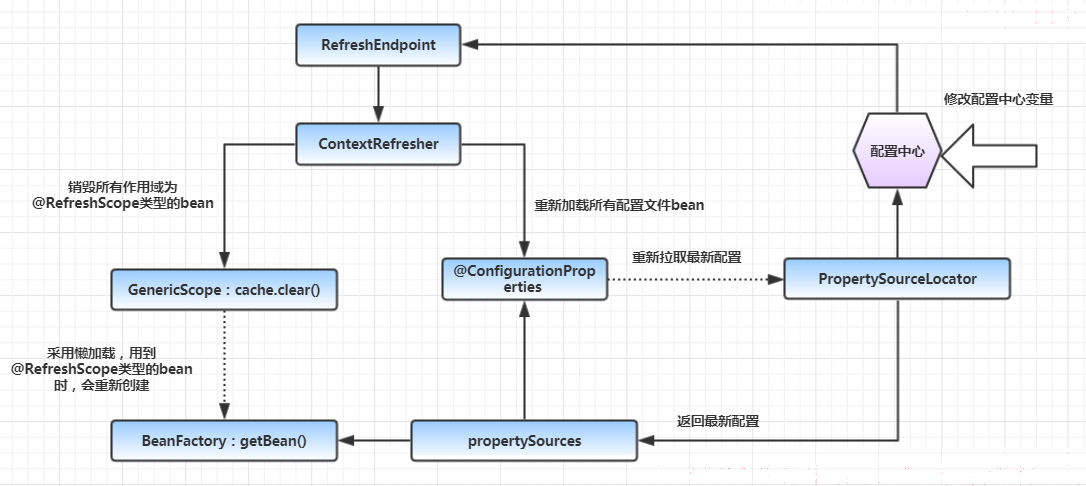09、Spring Cloud Config 动态刷新
概述
Spring Cloud 默认实现了配置中心动态刷新的功能,在公共模块 spring-cloud-context 包中。目前比较流行的配置中心 Spring Cloud Config 动态刷新便是依赖此模块,而Nacos动态刷新机制是在此模块上做了扩展,比Spring Cloud Config功能更强大丰富。
首先Spring Cloud Config 动态刷新需要依赖 Spring Cloud Bus,而 Nacos 则是在后台修改后直接推送到各服务。
其次,Spring Cloud Config的刷新机制针对所有修改的变量,只有有改动,后台就会获取。而Nacos则是支持粒度更细的方式,只有 refresh 属性为 true 的配置项,才会在运行的过程中变更为新的值。这时Nacos特有的方式。
相同点:两种配置中心动态刷新的范围都是以下两种:
- @ConfigurationProperties 注解的配置类
- @RefreshScope 注解的bean
大致的核心流程如下:

分别看一下这两点的实现原理。
首先 spring cloud config 动态刷新功能通过以下变量来确定是否开启,默认为true。
@ConditionalOnProperty(value = “endpoints.refresh.enabled”, matchIfMissing = true)
RefreshEndpoint 端点暴露方式:
public class LifecycleMvcEndpointAutoConfiguration {
@Bean
@ConditionalOnBean(RefreshEndpoint.class)
public MvcEndpoint refreshMvcEndpoint(RefreshEndpoint endpoint) {
return new GenericPostableMvcEndpoint(endpoint);
}
}
// Mvc适配器
public class GenericPostableMvcEndpoint extends EndpointMvcAdapter {
//代理类为RefreshEndpoint
public GenericPostableMvcEndpoint(Endpoint<?> delegate) {
super(delegate);
}
@RequestMapping(method = RequestMethod.POST)
@ResponseBody
@Override
public Object invoke() {
if (!getDelegate().isEnabled()) {
return new ResponseEntity<>(Collections.singletonMap(
"message", "This endpoint is disabled"), HttpStatus.NOT_FOUND);
}
return super.invoke();
}
}
这里的实现方式同 springboot actuator endpoint原理一样,都是通过 EndpointMvcAdapter 适配器来代理实现。
RefreshEndpoint 端点:
public class RefreshEndpoint extends AbstractEndpoint<Collection<String>> {
private ContextRefresher contextRefresher;
public String[] refresh() {
Set<String> keys = contextRefresher.refresh();
return keys.toArray(new String[keys.size()]);
}
@Override
public Collection<String> invoke() {
return Arrays.asList(refresh());
}
}
具体的刷新逻辑在 ContextRefresher 中。
配置ContextRefresher 刷新类:
public class ContextRefresher {
//......
private ConfigurableApplicationContext context;
private RefreshScope scope;
public synchronized Set<String> refresh() {
//提取之前的属性配置
Map<String, Object> before = extract(
this.context.getEnvironment().getPropertySources());
//获取最新的属性配置
addConfigFilesToEnvironment();
//获取发生变化的属性
Set<String> keys = changes(before,
extract(this.context.getEnvironment().getPropertySources())).keySet();
//发布EnvironmentChangeEvent事件
this.context.publishEvent(new EnvironmentChangeEvent(keys));
//刷新 RefreshScope Bean
this.scope.refreshAll();
return keys;
}
//......
}
addConfigFilesToEnvironment();上述代码通过该方法重新获取配置:
private void addConfigFilesToEnvironment() {
ConfigurableApplicationContext capture = null;
try {
StandardEnvironment environment = copyEnvironment(
this.context.getEnvironment());
//这里重新创建 springboot启动类,重新启动时,通过配置中心会就会重新获取配置了
capture = new SpringApplicationBuilder(Empty.class).bannerMode(Mode.OFF)
.web(false).environment(environment).run();
if (environment.getPropertySources().contains(REFRESH_ARGS_PROPERTY_SOURCE)) {
environment.getPropertySources().remove(REFRESH_ARGS_PROPERTY_SOURCE);
}
MutablePropertySources target = this.context.getEnvironment()
.getPropertySources();
String targetName = null;
}
}
通过SpringApplicationBuilder重新创建启动类,启动时就会重新拉取最新配置,然后发布 EnvironmentChangeEvent事件,通过对应的监听器重新加载带有@ConfigurationProperties 的配置类和作用域为 @RefreshScope 的bean。
@ConfigurationProperties
默认有两个监听器会监听到 EnvironmentChangeEvent 事件:
- ConfigurationPropertiesRebinder
- LoggingRebinder
LoggingRebinder只是设置日志级别,这里不做展开。
来看一下ConfigurationPropertiesRebinder:
public class ConfigurationPropertiesRebinder
implements ApplicationContextAware, ApplicationListener<EnvironmentChangeEvent> {
//用来收集所有@ConfigurationProperties 注解的bean
private ConfigurationPropertiesBeans beans;
private ConfigurationPropertiesBindingPostProcessor binder;
public ConfigurationPropertiesRebinder(
ConfigurationPropertiesBindingPostProcessor binder,
ConfigurationPropertiesBeans beans) {
this.binder = binder;
this.beans = beans;
}
@ManagedOperation
public void rebind() {
this.errors.clear();
for (String name : this.beans.getBeanNames()) {
rebind(name);
}
}
@ManagedOperation
public boolean rebind(String name) {
if (!this.beans.getBeanNames().contains(name)) {
return false;
}
if (this.applicationContext != null) {
try {
// 获取当前bean
Object bean = this.applicationContext.getBean(name);
// 重新绑定对应属性
this.binder.postProcessBeforeInitialization(bean, name);
// 重新执行bean初始化流程
this.applicationContext.getAutowireCapableBeanFactory()
.initializeBean(bean, name);
return true;
}
catch (RuntimeException e) {
this.errors.put(name, e);
throw e;
}
}
return false;
}
//触发监听器
@Override
public void onApplicationEvent(EnvironmentChangeEvent event) {
rebind();
}
}
上述代码即为属性配置类重写加载的过程。
另外,ConfigurationPropertiesBeans肯定是提前收集好所有@ConfigurationProperties注解的bean,来看一下收集方式:
public class ConfigurationPropertiesBeans implements BeanPostProcessor,
ApplicationContextAware {
private Map<String, Object> beans = new HashMap<String, Object>();
private String refreshScope;
@Override
public Object postProcessBeforeInitialization(Object bean, String beanName)
throws BeansException {
if (isRefreshScoped(beanName)) {
return bean;
}
ConfigurationProperties annotation = AnnotationUtils.findAnnotation(
bean.getClass(), ConfigurationProperties.class);
if (annotation != null) {
this.beans.put(beanName, bean);
}
else if (this.metaData != null) {
annotation = this.metaData.findFactoryAnnotation(beanName,
ConfigurationProperties.class);
if (annotation != null) {
this.beans.put(beanName, bean);
}
}
return bean;
}
}
通过BeanPostProcessor扩展接口,然后排除掉refreshScope类型的bean,然后收集对应的属性配置bean。
@RefreshScope
该注解是 Spring Cloud 对bean 作用域做的扩展类型,这种类型的bean生命周期和单例不同,从当前使用该,每一次调用调用/refresh方法都会清除所有该类型的bean。下次使用时,就会重新创建,然后注入最新属性变量。
具体来看一下代码。
public class RefreshScope extends GenericScope
implements ApplicationContextAware, BeanDefinitionRegistryPostProcessor, Ordered {
//......
@ManagedOperation(description = "Dispose of the current instance of all beans in this scope and force a refresh on next method execution.")
public void refreshAll() {
//调用清除缓存方法
super.destroy();
this.context.publishEvent(new RefreshScopeRefreshedEvent());
}
//......
}
public class GenericScope implements Scope, BeanFactoryPostProcessor, DisposableBean {
@Override
public void destroy() {
List<Throwable> errors = new ArrayList<Throwable>();
//清除缓存
Collection<BeanLifecycleWrapper> wrappers = this.cache.clear();
for (BeanLifecycleWrapper wrapper : wrappers) {
try {
//销毁所有 @RefreshScope 类型的bean
wrapper.destroy();
}
catch (RuntimeException e) {
errors.add(e);
}
}
if (!errors.isEmpty()) {
throw wrapIfNecessary(errors.get(0));
}
this.errors.clear();
}
}
被销毁的bean 再下次使用时,会重新创建,这样已满足配置动态刷新的需求了。但是有些时候,在清除这些bean之后,想执行一些自定义的监听逻辑,怎么做呢?
Spring Cloud同样提供了相应的事件:RefreshScopeRefreshedEvent。在refreshAll方法在清除缓存之后,会发布该事件:
this.context.publishEvent(new RefreshScopeRefreshedEvent());
这里是留的扩展,如果有需要可以做一些扩展。目前在源码中看到 Zuul,Nacos都监听了该事件,具体细节有兴趣的可以去研究。
版权声明:「DDKK.COM 弟弟快看,程序员编程资料站」本站文章,版权归原作者所有